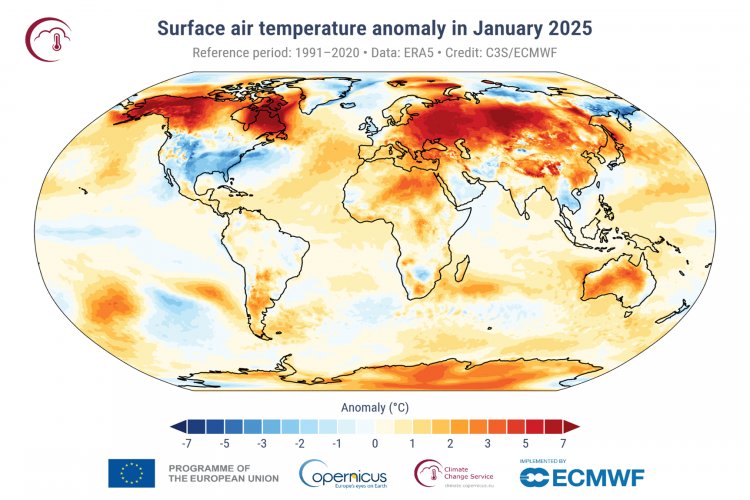January 2025 recorded as the warmest globally, despite emerging La Niña
The data, derived from the ERA5 reanalysis dataset, underscores an ongoing trend of rising global temperatures, driven largely by human-induced climate change.

The world experienced its warmest January on record in 2025, with global temperatures surpassing previous highs despite the onset of La Niña, according to the Copernicus Climate Change Service (C3S). January 2025 was the warmest January globally with an average surface air temperature of 1.75°C above the pre-industrial level and 0.79°C above the 1991-2020 average.
Copernicus is the European Union's Earth Observation Programme, which routinely publishes monthly climate bulletins reporting on changes observed in global surface air and sea temperatures, sea ice cover, and hydrological variables. The data, derived from the ERA5 reanalysis dataset, underscore an ongoing trend of rising global temperatures, driven largely by human-induced climate change.
The year 2024 was the warmest on record globally, with an average global temperature of 1.6ºC above the pre-industrial average. It was the first calendar year with a global average temperature exceeding 1.5°C above pre-industrial level.
Global Temperature Surge
Copernicus reports that the global average surface air temperature for January 2025 reached 13.23°C, marking an increase of 0.79°C above the 1991-2020 average. More significantly, the month was 1.75°C warmer than pre-industrial levels, continuing a pattern observed over the last 19 months, during which 18 months have exceeded the 1.5°C threshold above pre-industrial levels.
Over the last 12-months period (February 2024 – January 2025) the global temperature has averaged 0.73°C above the 1991-2020 baseline and 1.61°C above pre-industrial estimates. While other datasets may not fully align with the ERA5 findings due to small margins of temperature differences, the overarching warming trend remains clear.
Regional Temperature Variations
In Europe, January 2025 ranked as the second-warmest January on record, with land temperatures averaging 1.80°C, which is 2.51°C above the 1991-2020 norm. Southern and eastern Europe, including western Russia, saw the most significant deviations, while Iceland, the United Kingdom, Ireland, northern France, and northern Fennoscandia experienced below-average temperatures.
Outside Europe, northeastern and northwestern Canada, Alaska, and Siberia reported significantly above-average temperatures. Warmer-than-average conditions also prevailed in southern South America, Africa, Australia, and parts of Antarctica. Conversely, the United States, eastern Russia, the Arabian Peninsula, and mainland Southeast Asia saw below-average temperatures.
Climate Experts Warn of Persistent Warming
Samantha Burgess, Strategic Lead for Climate at European Centre for Medium-Range Weather Forecasts (ECMWF), highlighted the alarming persistence of high temperatures, saying, "January 2025 is another surprising month, continuing the record temperatures observed throughout the last two years, despite the development of La Niña conditions in the tropical Pacific and their temporary cooling effect on global temperatures. Copernicus will continue to closely monitor ocean temperatures and their influence on our evolving climate throughout 2025."
The data from January 2025 reinforces the urgency of addressing climate change as rising global temperatures continue to challenge climate adaptation efforts worldwide.



 Join the RuralVoice whatsapp group
Join the RuralVoice whatsapp group








































